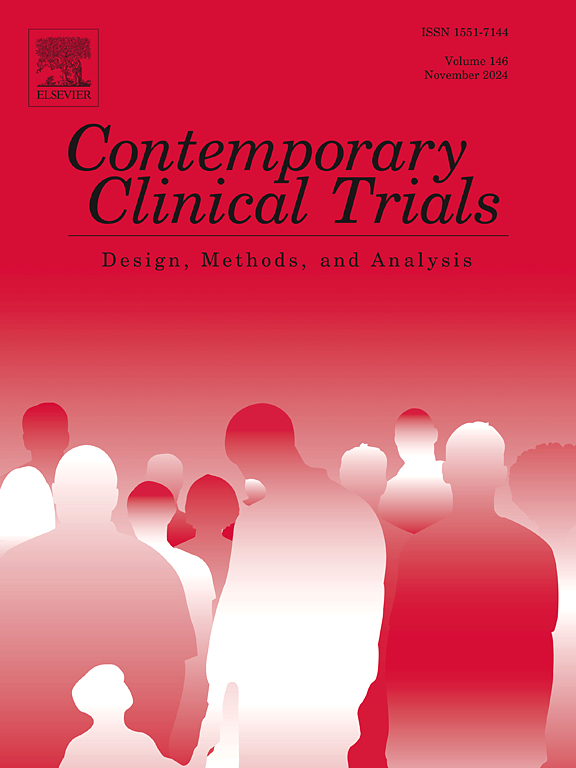The eACT study design and methods: A sequential, multiple assignment, randomized trial of A novel adherence intervention for youth with epilepsy
IF 1.9
3区 医学
Q3 MEDICINE, RESEARCH & EXPERIMENTAL
引用次数: 0
Abstract
Background
Epilepsy is a common, chronic pediatric neurological condition predominately treated with anti-seizure medications (ASMs) to control or reduce seizures. Approximately 60 % of youth with epilepsy demonstrate suboptimal adherence to their ASM. This paper describes the methodology, recruitment, design, and baseline participant characteristics of a sequential, multiple assignment, randomized trial (SMART) designed to test the effectiveness of a behavioral health intervention to improve adherence in families of young children with epilepsy.
Methods
Using a two-stage SMART, youth ages 2–12 years old with newly diagnosed epilepsy and their families were enrolled. Following an 8-week run-in phase, families with ≤95 % adherence were randomized to control (education + automated digital reminders) or intervention (education + automated digital reminders + individualized feedback) arms. After three months, families in the intervention group who remained non-adherent (i.e., ≤ 95 %) were re-randomized to 1) continue with same intervention or 2) receive two telehealth problem-solving sessions with an interventionist over the next two months. Study measures were completed at baseline, 8-, 14-, and 20-months post-baseline.
Results
Of the n = 466 ethnically and racially diverse study participants, n = 268 participants were non-adherent and were randomized. The primary outcome was electronically monitored ASM adherence at post-intervention, while secondary outcomes included seizure freedom, health care utilization, and epilepsy-specific health-related quality of life.
Conclusions
Novel aspects of the trial design (e.g., sequential, recruitment of racial and ethnic diverse youth), modifications to the protocol related to the COVID-19 pandemic and evolving socio-political and medical climate, as well as recruitment and retention challenges are discussed.
ClinicalTrials.gov Number: NCT03817229
eACT 研究的设计和方法:一项针对青少年癫痫患者的新型坚持治疗干预的连续、多重分配、随机试验。
背景:癫痫是一种常见的慢性儿科神经系统疾病,主要通过抗癫痫药物(ASM)来控制或减少癫痫发作。约 60% 的青少年癫痫患者对抗癫痫药物的依从性不佳。本文介绍了一项顺序、多重分配、随机试验(SMART)的方法、招募、设计和基线参与者特征,该试验旨在测试行为健康干预对改善癫痫幼儿家庭依从性的有效性:方法:采用两阶段 SMART,招募 2-12 岁新确诊癫痫的青少年及其家庭。在为期8周的磨合阶段后,依从性低于95%的家庭被随机分配到对照组(教育+自动数字提醒)或干预组(教育+自动数字提醒+个性化反馈)。三个月后,干预组中仍未坚持治疗的家庭(即坚持率低于 95%)被重新随机分配为:1)继续接受相同的干预;或 2)在接下来的两个月中接受两次由干预专家提供的远程医疗问题解决课程。在基线、基线后 8 个月、14 个月和 20 个月完成研究测量:在 n = 466 名不同民族和种族的研究参与者中,n = 268 名参与者未坚持治疗,他们被随机分组。主要结果是干预后电子监测的ASM依从性,次要结果包括癫痫发作自由度、医疗保健利用率以及与癫痫相关的健康生活质量:讨论了试验设计的新颖之处(如顺序、招募不同种族和民族的青少年)、与 COVID-19 大流行和不断变化的社会政治和医疗环境相关的方案修改,以及招募和留住人员方面的挑战:NCT03817229。
本文章由计算机程序翻译,如有差异,请以英文原文为准。
求助全文
约1分钟内获得全文
求助全文
来源期刊
CiteScore
3.70
自引率
4.50%
发文量
281
审稿时长
44 days
期刊介绍:
Contemporary Clinical Trials is an international peer reviewed journal that publishes manuscripts pertaining to all aspects of clinical trials, including, but not limited to, design, conduct, analysis, regulation and ethics. Manuscripts submitted should appeal to a readership drawn from disciplines including medicine, biostatistics, epidemiology, computer science, management science, behavioural science, pharmaceutical science, and bioethics. Full-length papers and short communications not exceeding 1,500 words, as well as systemic reviews of clinical trials and methodologies will be published. Perspectives/commentaries on current issues and the impact of clinical trials on the practice of medicine and health policy are also welcome.

 求助内容:
求助内容: 应助结果提醒方式:
应助结果提醒方式:


